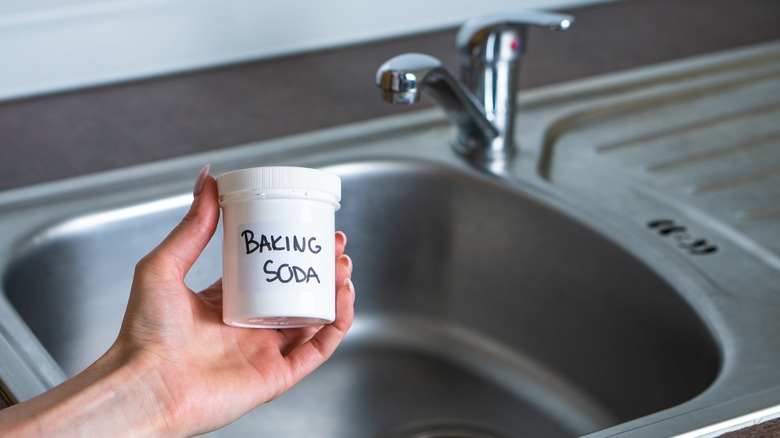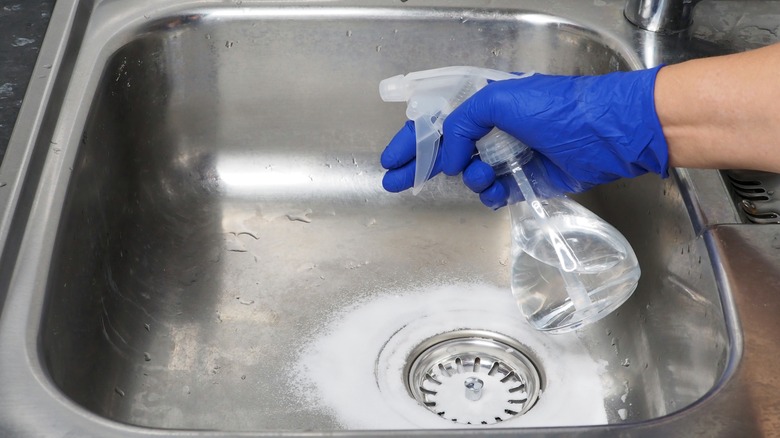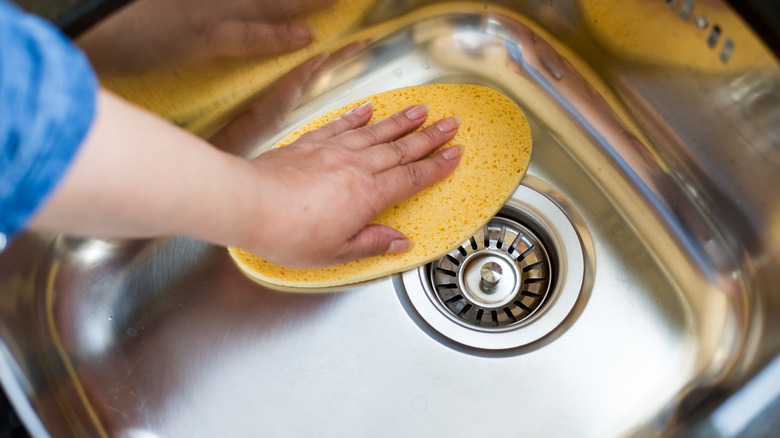How To Clean A Stainless Steel Sink So It's Streak-Free
Cleaning the kitchen sink is ideally a daily affair. Using a designated rag or sponge, a quick wipe-down at the end of every day is ideal to rid it of any food stains and grime. In addition to that, it's good practice to do a deep clean at least once a week or so, especially because it's part of the kitchen that sees so much traffic.
Whether "doing the dishes" means rinsing dishes before loading the dishwasher or washing dishes by hand, you can use your regular dish soap to get rid of stains and germs in the sink after doing the dishes, washing it just like you would a large bowl. However, if you're the owner of a stainless steel kitchen sink, you would know that soap can't get rid of water stains and may even add soap scum to the issue. Minerals from tap water build up in the sink, leaving visible streaks.
There's a simple and natural solution to the problem, and you likely already have it in your kitchen... in your pantry! Baking soda is one of the best multipurpose household cleaners, working wonders on a variety of surfaces and situations, including getting your kitchen sink squeaky clean. Simply make a loose paste of baking soda and water, then use a microfiber cloth to rub the paste all over the sink. Make sure to rub the cloth in the direction of the grain of your sink (yes, stainless steel has grain!) for optimum streak-free results.
How does baking soda clean stainless steel?
More and more folks are (or should be!) choosing natural solutions over synthetic cleaners. And since baking soda is literally edible, what could be more natural than that? Baking soda is usually used in the kitchen to leaven baked goods or tenderize meat thanks to its alkaline pH (more on that in a bit). So why not harness this exact alkalinity as a household cleaner?
First of all, what exactly is baking soda? This substance naturally occurs in powder form and has been used for millennia in both cleaning and baking applications. Its other names include "sodium bicarbonate" and "bicarbonate of soda," which you may have heard on a certain British baking show. This alkaline then reacts with acids to produce little carbon dioxide bubbles that lift your baked goods or make it difficult for meat proteins to bond, resulting in velvety meat.
Another feature of alkalinity is that it is corrosive to a degree, which means that it can break down the food particles that make up the stains in the sink. It also helps remove surface rust, keeping your sink bright and shiny. Distilled white vinegar works similarly, though being an acid, comes at the process from the other end of the pH scale.
Extra tips for extra shine
While distilled white vinegar can be used instead of baking soda, it can also be used in tandem with it. Using both substances together releases carbon dioxide in the form of gas (the same reaction that lifts your cakes!), and with it, helps physically remove stains. Though remember, because one is an acid and one is an alkali, it will naturally produce water when it mixes, so Live Science recommends "not combine them in equal amounts because you need to keep the mixture in either the acidic or basic side of the neutral value." Why? So that combining the two causes the bubbly release of gas in the first place, but at the same time, it does not fully neutralize into water so that it can still retain its corrosive capabilities.
Apart from the sink, you can incorporate baking soda into your kitchen cleaning arsenal for the fridge, oven, stovetop, and even the floors and counters! However, while baking soda can be used to clean a majority of different materials and surfaces, there are some things you should not clean with it, like glass and wood.
Once the sink is physically clean, you can go the whole nine yards and polish it to a shine. All you'll need is a microfiber cloth dabbed into a little baby oil, then gently work it into the surface of a stainless steel sink. Your dinner guests will be left wondering if you just got a new sink installed.


